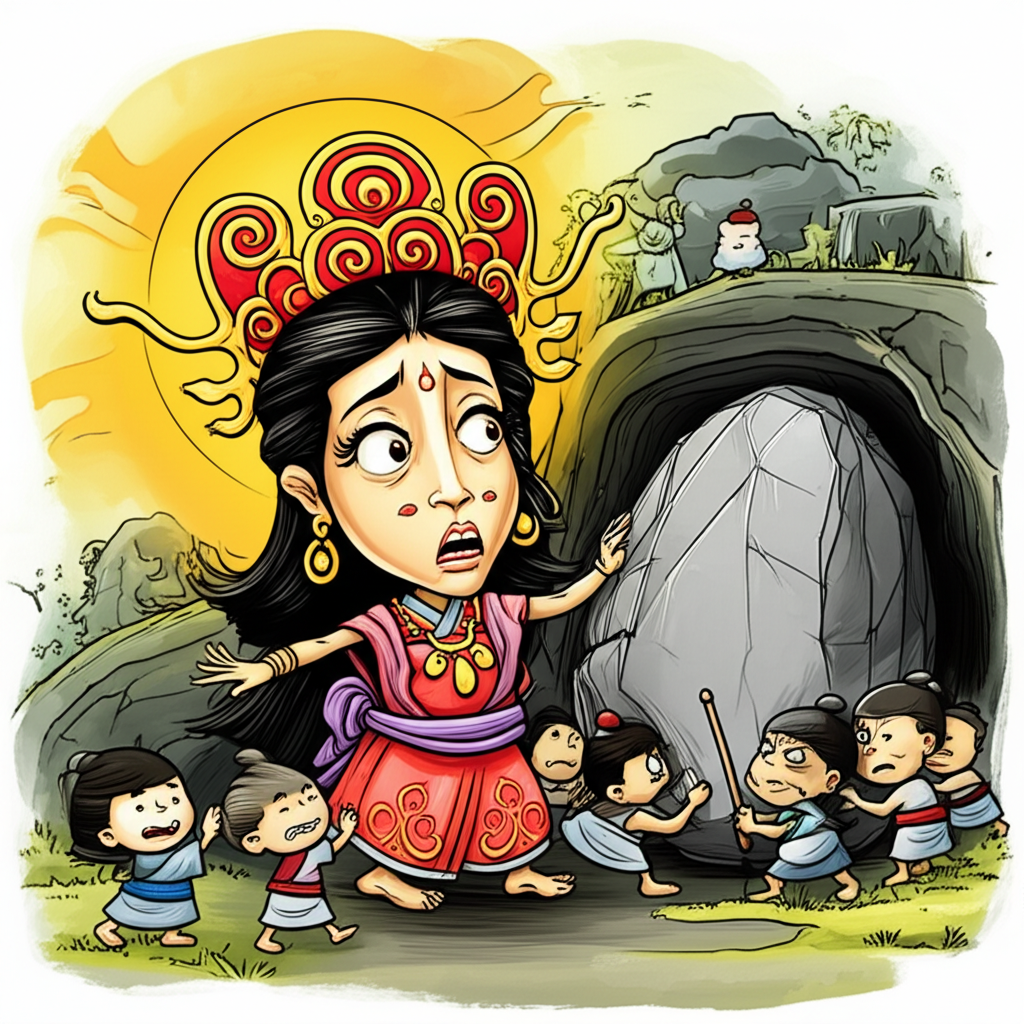
From the rich tapestry of ancient Japanese folklore emerges a captivating narrative, a story passed down through generations, not as historical fact, but as a vibrant testament to the imagination of a people deeply connected to the natural world. This is the tale of Amaterasu, the sun goddess, and her dramatic retreat into a celestial cave, an event that plunged the world into darkness and sparked a peculiar kind of "war." This myth, originating from the Shinto tradition of Japan, offers a fascinating glimpse into how early societies sought to understand the fundamental forces of existence.
The era in which these stories took root was one where the lines between the observable world and the spiritual realm were blurred. Ancient Japanese society, agrarian and deeply influenced by the cycles of nature, viewed the sun not merely as a celestial body, but as a powerful, life-giving deity. The changing seasons, the warmth that ripened crops, the very dawn that dispelled the fears of night – all these were attributed to divine forces. The pantheon of Shinto gods, known as kami, were seen as immanent in the world around them, residing in mountains, rivers, trees, and the very phenomena of the sky. This worldview fostered a deep respect for nature and a desire to appease and understand the forces that governed it. The myths, therefore, served a crucial purpose: to explain the inexplicable, to provide a framework for understanding cosmic events, and to imbue the natural world with meaning and personality.
At the heart of this particular myth stands Amaterasu, often depicted as a radiant, benevolent goddess. In symbolic terms, she represents the sun itself – its brilliance, its warmth, its life-sustaining power, and its role in bringing order to the world. Her association with the sun signifies illumination, clarity, and the dispelling of darkness. She is often described with regal bearing, a queen of the heavens, embodying principles of divinity, truth, and cosmic harmony. Her story is not one of a tangible being with physical attributes in the way we understand them today, but rather a personification of immense natural power and its influence on the world.
The narrative of Amaterasu’s retreat begins with a profound disturbance caused by her tempestuous brother, Susanoo-no-Mikoto, the god of storms and the sea. While the exact nature of Susanoo’s transgressions varies in different tellings, they were consistently acts of violence and disrespect that deeply grieved Amaterasu. In one prominent version, Susanoo destroys Amaterasu’s rice fields, defiles her sacred weaving hall, and, most grievously, throws a flayed horse into the hall while she is weaving, causing her immense shock and injury. Overwhelmed by sorrow and outrage at her brother’s destructive behavior, Amaterasu, the source of all light and warmth, decides she can no longer bear to witness such chaos and wickedness. She retreats into a heavenly cave, a place of profound darkness, sealing herself within.
The moment Amaterasu withdrew, the world was plunged into an unprecedented and terrifying darkness. The sun, the very heart of the cosmos, had vanished. Days turned into nights, crops withered, and despair gripped the land. The other kami, sensing the catastrophic imbalance, were filled with dread. They understood that without Amaterasu’s light, life itself was threatened. This absence of light became the catalyst for a desperate effort to coax her back.
A council of the gods was convened. They debated, strategized, and lamented. The solution, however, could not be found through force or threat, for Amaterasu was a deity of immense power and her will was not to be broken by coercion. Instead, they devised a plan centered on joy, distraction, and the sheer irresistible pull of celebration.
The god of wisdom, Omoikane, is often credited with devising the ingenious plan. He instructed the goddess Uzume-no-Mikoto, a lively and spirited figure, to perform a dance outside the cave entrance. Uzume, with her infectious energy, began a wild and comical performance. She tied up her hair with vines, put on a daringly provocative outfit, and began to stomp and gyrate with such abandon that the other kami roared with laughter. This raucous celebration, this eruption of unrestrained mirth, was designed to pique Amaterasu’s curiosity.
Meanwhile, another god, Ishikoridome-me, fashioned a magnificent mirror, a radiant object that would reflect the brilliance of the sun. This mirror was placed outside the cave, positioned so that when Amaterasu eventually peeked out, she would be confronted with her own dazzling reflection.
The cacophony of laughter and the allure of the shimmering mirror eventually succeeded. Amaterasu, hearing the unusual sounds of revelry and perhaps sensing a familiar brilliance, cautiously opened the cave door a crack to peer outside. As she did, the mirror caught her gaze, reflecting an image of unparalleled radiance. At the same moment, the powerful god Ame-no-Tajikara-o, positioned strategically, seized the opportunity and forcefully pulled the cave door open wide, preventing Amaterasu from retreating further.
With Amaterasu’s return to the world, light and warmth flooded back, banishing the darkness. The kami rejoiced, and order was restored. Susanoo, though eventually pardoned and tasked with certain duties, was forever marked by his disruptive behavior, and the story served as a cautionary tale about the consequences of unchecked rage and disrespect. The "war" was not one of swords and shields, but a war of ingenuity, collective effort, and the power of joy to overcome despair.
The symbolism embedded within this myth is profound and multifaceted. Amaterasu’s retreat and return can be interpreted as a metaphorical explanation for the cycles of day and night, or perhaps even for periods of drought or hardship followed by renewal. Her initial withdrawal represents the consequences of discord and the disruption of natural harmony. The subsequent efforts to coax her back highlight the importance of community, collective action, and the use of positive forces like joy and curiosity to resolve conflict. The mirror symbolizes self-reflection and the recognition of one’s own power, while Uzume’s dance embodies the power of art, entertainment, and uninhibited expression to bring about change and restore balance. The myth also speaks to leadership and responsibility; Amaterasu, as the sun goddess, has a duty to illuminate and sustain, and her absence creates a crisis that requires the intervention of the entire divine community.
In modern times, the myth of Amaterasu and the War of the Celestial Cave continues to resonate. It appears in various forms of Japanese literature, art, and performance. In popular culture, Amaterasu is a recurring figure in anime, manga, and video games, often depicted as a powerful, benevolent, or even formidable deity. Her story is studied in cultural anthropology and religious studies as an example of ancient Japanese cosmology and the development of Shinto beliefs. These interpretations often focus on the narrative’s archetypal themes of light versus darkness, order versus chaos, and the power of collective action.
It is important to reiterate that this compelling narrative is a product of ancient storytelling traditions, a myth woven from the threads of human observation, imagination, and a deep desire to understand the world. As Muslims, we recognize that the true Creator and Sustainer of the universe is Allah (God) alone. These ancient stories, while rich in cultural heritage and imaginative power, are not to be considered divine truths. They offer us, however, a valuable window into the past, a glimpse into the ways in which our ancestors grappled with the mysteries of existence. They remind us of the enduring power of storytelling to shape our understanding, to entertain, and to preserve the cultural legacy of human ingenuity and the boundless scope of the human imagination.





